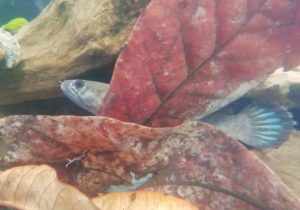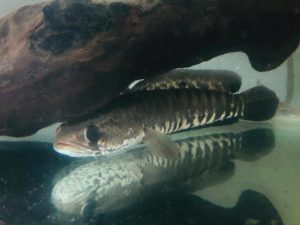Updated: 29/04/2020
Taxonomic Tree
Domain: Eukaryota
Kingdom: Metazoa
Phylum: Chordata
Subphylum: Vertebrata
Class: Actinopterygii
Order: Perciformes
Suborder: Channoidei
Family: Channidae
Genus: Channa

Channa is a genus that belongs to the family Channidae and commonly known as snakeheads. There are more than 50+ separated species all over the world. All Snakeheads live in freshwater. They have scales in the head unlike other fish and it is the reason to call them “Snakeheads”. Highly carnivorous and active predators. Because of that, most of the time snakeheads are the apex predators of freshwater bodies. They have well-developed teeth. Usually feed on small fish, amphibians, crustaceans and sometimes on animals that bigger than them. There are records of attacking birds also. The Snakeheads have sub-cylindrical bodies and long dorsal fins. They are labyrinth fish. It means all of them to have a special organ call labyrinth and it helps to take oxygen directly from the air, instead of taking it from the water through gills. And snakeheads can breathe by gills also. Because of that, they come to the water surface frequently. Adults can store more air than juveniles. Adult snakeheads can stay more time in the water without going to the surface to breathe than juveniles accordingly. They lay a lot of eggs at once in a nest that they developed in a shady place such as floating vegetation or among roots near the banks. After mating, the females lay their eggs and the eggs are fertilized by the males. Snakeheads are monogamous and show highly developed parental care. Eggs are guarded by parents till hatchlings come out. The eggs generally hatch about in four days. Both male and female parents protect juveniles from predators by hanging around them always. Most of the time they are the apex predators of their habitat. Their juveniles don’t have a predator. But their population size is maintained by cannibalism. The juveniles that have dominant and strong traits feed on weaker ones. After all, very few adults have remained. Otherwise, they could be overpopulated. Always overpopulation leads to extinction. There is a record that Northern Snakehead is attacking a human.
In Sri Lanka, there are 6 species of snakeheads and 2 of them are endemic to Sri Lanka. Channa ara, Channa striata, Channa marulius, Channa orientalis, Channa kelaartii and Channa punctata. Among them, Channa ara and Channa orientalis are the species that endemic to Sri Lanka. Channa ara is the biggest endemic fish in Sri Lanka. Those snakeheads live in like every waterbody from a small pond to deeper rivers. They usually live in shaded areas where near the banks. The living shore is different from species to species. Snakeheads can be found in both types of water bodies that have the bottom with gravel or sand. Some species live in water streams and some in stable waterbodies.
6 species of Channa occur in Sri Lanka,
01.Channa ara
Ophiocephalus marulius Hamilton, 1822
Ophiocephalus aurolineatus
Channa marulius

The biggest endemic fish in Sri Lanka. Highly carnivorous and active predators. Usually feed on fish, amphibians, and crustaceans. According to the latest studies by Hiranya Sudasinghe, Channa ara is distributed throughout the Mahaweli river basin and Channa cf ara is distributed throughout the Kalu and Nilwala basin (South-Western area). Endemic to Sri Lanka. In the breeding, they build a floating nest in floating vegetation in a shaded place. They grow up to 1m long. Channa ara has various body colours from Grey to black and have the ability to change the body colour rapidly. They have white or yellow coloured, square-shaped patches in the lateral body. Adults have white spots. Generally, found in deep rivers and lakes. Habitat destruction, pollution and overfishing for food are the main threats facing them in the wild, the ornamental fish trade may have adverse effects as a result of the introduction of nonnative organisms, and by the direct depletion of wild stocks.
02.Channa marulias (Giant Snakehead)
Ophiocephalus marulius Hamilton, 1822
Ophiocephalus aurolineatus
The biggest Snakehead species in Sri Lanka. Distributed throughout the dry zone of Sri Lanka, South and South-East Asia. Their breeding is seasonal and also build a floating nest in floating vegetation like Channa ara. Grow up to 1m+. Body colour can be changed from grey to black. Highly carnivorous and active predators. Overfishing for food and habitat loss are the main threats for them. Generally, the active predators of the community that they lived. Usually, they can be found in deep rivers and lakes. An expensive fish in the ornamental fish trade. Males are highly territorial.
View this post on Instagram
03.Channa striata (Murrel Snakehead)
Ophiocephalus striata Bloch, 1793

The most common Snakehead fish in Sri Lanka. Channa Striata can be found all over the country. Commonly known as “Loola”. They have a dark grey coloured body with white coloured stripes over the lateral body. Usually, live in all type of water bodies such as rivers, lakes, water streams and ponds. Highly predatory. They play a major role in the aquatic ecosystem of Sri Lanka because they are the most spread predator fish in Sri Lanka. Mainly, feed on small fish, amphibians and crustaceans. Grow up to about 50cm. Overfishing for food is the main threat for them.

04.Channa orientalis (Smooth-breasted Snakehead)
Channa orientalis Bloch & Schneider, 1801

An endemic fish to Sri Lanka. C.orientalis is distributed throughout the South-Western wet zone. The 2nd smallest Snakehead of Sri Lanka. Maximum 10cm in size. Usually live in small, shaded water streams with a little depth in shaded areas. The main difference between C.gachua and C.orientalis is the absence of pelvic fins for C.orientalis. They are brownish-grey in colour. Active predator. Mainly feed on little fish and crustaceans like shrimps. They lay eggs in floating vegetation or among roots near the banks. Habitat destruction is the main threat facing them in the wild.
05. Channa kelaartii
Ophiocephalus kelaartii
Ophiocephalus gachua
Ophiocephalus gachua kelaartii
Channa gachua
Channa orientalis

According to the latest studies by Hiranya Sudasinghe, Channa kelaartii is distinguished from Channa gachua mainly by the lateral head shape. Their lateral head profile pointed anteriorly unlike Channa gachua. Pelvic fins present. Have an elongated, slender body. There are various colour varieties of Channa kelaartii. The smallest Snakehead in Sri Lanka. Distributed throughout the island including the central hills up to 600m of elevation. Brown in colour. They could be easily identified by the orange coloured margin in the dorsal fin. Usually, live in water streams and occasionally in small ponds. Active predator which mainly feeds on small fish and crustaceans like shrimps. Their main threat is habitat loss due to human activities.
06.Channa punctata (Spotted Snakehead)
Ophiocephalus punctatus Bloch, 1794


Commonly shown in olive green and brown. There are several dark yellow coloured blotches along the side. Distributed throughout the low land of Sri Lanka, including the coastal marshes and their peripheral (brackish) waters. And also they are common in India. Active predator and mainly feed on worms, small fish and small shrimps. A popular food fish and it is the main threat facing them in the wild. Usually, live in medium-sized water streams and occasionally in lakes. They lay eggs in shallow water with a silty substrate. Generally, don’t build nests. A popular food fish and it is the main threat facing them in the wild.
Reference: Freshwater Fishes of Sri Lanka by Rohan Pethiyagoda






